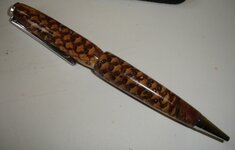byounghusband
Member
Hey all,
I just landed a nice $500 order and one of the pens is a Pine Cone Sierra. I got one a LONG time ago and don't remember where it came from. I loaded it up with thin CA and it came out great. Now I need to do another one. Anyone have any blanks?
Thanks!!
I just landed a nice $500 order and one of the pens is a Pine Cone Sierra. I got one a LONG time ago and don't remember where it came from. I loaded it up with thin CA and it came out great. Now I need to do another one. Anyone have any blanks?
Thanks!!

